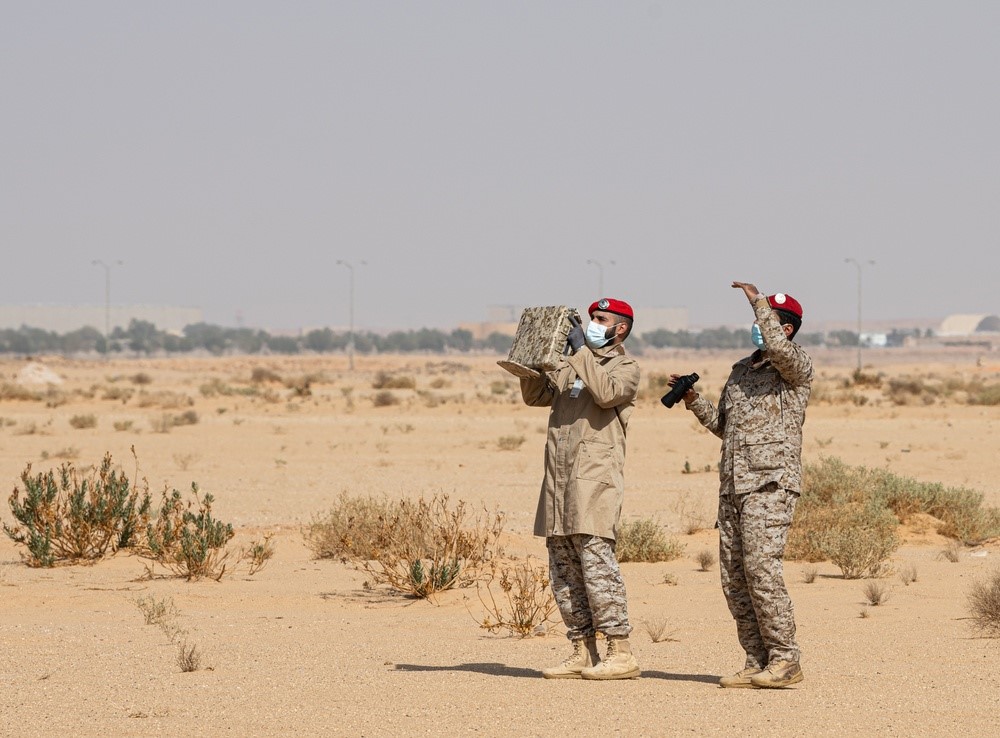
Personnel from the 378th Air Expeditionary Wing trained with Royal Saudi Air Force Police Wing members in a joint counter unmanned aerial system exercise Jan. 27, 2021 at Prince Sultan Air Base, Kingdom of Saudi Arabia.
“…Saudi Arabia has been very late in using unmanned weapons technologies and has relied on American weapons. The price of this delay has been Iran’s expansion in the region…”
Saudi Arabia’s domestic UAV program continues to develop at what some consider a snail’s pace. While Houthi-led forces in Yemen have relied extensively on domestically assembled drones, using Iranian technology and foreign-sourced components, Saudi forces have yet to employ any of their domestic UAV technology on the Yemeni battlefield. Saudi companies have contracted with Chinese and Turkish UAV manufacturers to assemble CH-4 and Karayel drones in Saudi territory, but there is an inherent expectation of a more robust Saudi domestic UAV industry, given the Houthis’ success in employing drones and the importance that Saudi Arabia’s “Vision 2030” development program gives to localizing military industry. According to the director of the Yemeni think tank Abaad for Studies and Research, Saudi delays in employing UAVs and its reliance on U.S. weaponry has been a critical element in allowing “Iran’s expansion in the region.”
The Saudi Arabian Military Industries (SAMI) recently announced that it would begin mass production of the “Sky Guard” UAV, a domestically developed platform that was initially scheduled for production in 2018. As noted in the accompanying excerpt from the military news website Defense News, Sky Guard is a tactical UAV intended for surveillance and electronic warfare, though it can also carry small munitions. Sky Guard joins another prominent Saudi domestic UAV project, the Saqr platform, which was first announced nearly a decade ago and went into production in 2017. Still, there is no indication that Saqr drones have been employed in Yemen or elsewhere.
Source:
Abdulsalam Mohammed (@salamyemen2), Twitter, 1 November 2021. https://twitter.com/salamyemen2/status/1455138763110330369
Riyadh intends to develop a homemade drone called Sky Guard. Will its effectiveness be tested in the Yemen war? Or is it too early for it to enter military operations?
Saudi Arabia has been very late in using unmanned weapons technologies and has relied on American weapons. The price of this delay has been Iran’s expansion in the region.
Source: “Two Saudi firms to co-produce Sky Guard drone for operational use,” Defense News (military news website), 20 August 2021. https://www.defensenews.com/unmanned/2021/08/20/two-saudi-firms-to-co-produce-sky-guard-drone-for-operational-use/
The drone was developed in 2015 and displayed in 2017 at Bahrain’s BIDEC event and the Emirati conference IDEX, with an original expected date of mass production in 2018, according to Jean-Marc Rickli, head of global and emerging risks at the Geneva Centre for Security Policy… “The payload is light, 50 kilograms; range relatively short, 150 kilometers; and endurance of 8 hours,” Rickli told Defense News. Sky Guard can also fly at a maximum altitude of 18,000 feet, and be equipped with high-resolution cameras as well as electronic warfare systems. “So this is a tactical UAV mainly used for surveillance and reconnaissance purposes. I don’t know if it has combat experience such as in Yemen,” he said, but if Saudi Arabia wants to export it, proven combat experience would help. Asked whether the system can carry guided munitions, Rickli said: “I don’t know specifically about this drone, but a payload of 50 kilograms — it is enough for transporting bombs.” “As its description mentions: It was designed to be highly adaptable with several subsystem configurations. Thus one cannot exclude that it can be weaponized.”
Image Information:
Image: Personnel from the 378th Air Expeditionary Wing trained with Royal Saudi Air Force Police Wing members in a joint counter unmanned aerial system exercise Jan. 27, 2021 at Prince Sultan Air Base, Kingdom of Saudi Arabia.
Source: Senior Airman Leala Marquez, https://www.dvidshub.net/image/6513425/joint-force-rsaf-perform-counter-uas-exercise
Attribution: Public Domain
